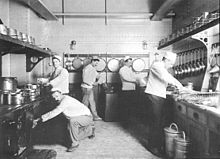caboose
Under galley is understood now generally the kitchen on a ship .
The word galley is on medium-Dutch kabuyse or kabuys returned and appears in the 15th century in the Middle Low German as Kabuse (see also cubbyhole ): Back then, it meant as much as wooden shed as a kitchen space on board, even small, low deckhouse for the kitchen.
On yachts , the kitchen is also known as a pantry . On larger ships, this term usually referred to a simple sideboard or small kitchen. But it can also designate the space for cleaning and storing the dishes.
The galley's chef is traditionally referred to as a smut or smutje . So-called backers may be assigned to support him. These are members of the ship's crew who take turns helping out in the kitchen. This applies to the German Navy .
On merchant ships , chef is the name given to the chef. Smut would be a bad insult as it means "the dingy one". Backshaft is made by the steward or the fair boy.
On passenger ships the chef for the passengers will cook called.
In Afrikaans today , kombuis generally means kitchen, as the language developed from the Dutch used by seafarers in the 17th century.
See also
- Aircraft galley
- Sailor's language
Web links
- Pierer's Universal Lexikon, Volume 9. Altenburg 1860, p. 673: Galley (Kambüse)
- Meyers Großes Konversations-Lexikon, Volume 11. Leipzig 1907, p. 318: Galley (Kambüse, Dutch kombuis, French cambuse), the ship's kitchen.
- Brockhaus' Kleines Konversations-Lexikon, fifth edition, volume 1. Leipzig 1911., p. 991: Galley (Dutch; French cambuse), ship's kitchen.

